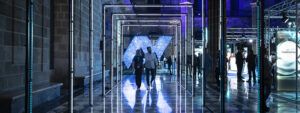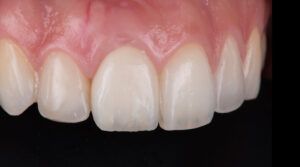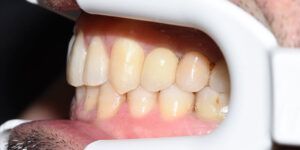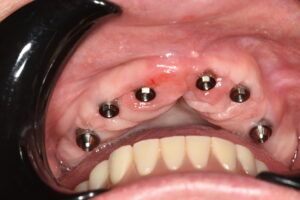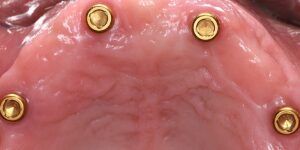Today’s digital processes have been gaining ground over traditional methods. Technological progress in all sectors and markets has led to a change in working processes and in the final result of the products and services. In the dental sector, in this case, processes such as diagnostics and dental printing have changed radically, becoming quicker and much more effective thanks to intraoral scanners.
Using intraoral scanners significantly improves not only the final result of the treatment, but also the patient’s experience, provided the scan is done properly.
But why is the quality of the scan so important?
A poor scan can limit the patient’s diagnosis and treatment design, therefore a good scanning strategy is primordial to avoid possible errors.
Some of the most common errors are usually:
· Inaccuracy of the scan in bridges
· Insufficient detail along the margin lines
· The scan stopping due to broken teeth
· Spending too long on the scan

3Shape, one of the most significant providers of intraoral scanners on the market, recommends following this scan protocol with 5 simple steps for perfect results using its TRIOS scanner.
A good scanning strategy is primordial to avoid possible errors.
The scan path consists of 3 sweeps to guarantee good data coverage of all the surfaces: occlusal, lingual and buccal.
The occlusal sweep always comes first. It should start at the first molar (if it is an antagonist) or the preparation (for scanning gums before collapse due to traction). Scan and wait 3 to 5 clicks before moving the scanner constantly and slowly 0 to 5 mm above the teeth.
Ensure you cover the lingual and labial sides, moving slowly as you scan the first central sweep, as the central teeth require more attention span than the molars.
Step 1: Start with the lower quadrant of the antagonist

1: Start with the antagonist. Start directly at the occlusion (first molar), then sweep along the occlusion.
2: Continue along the lower jaw. Rotate 45-90º toward the lingual side and slide up to the second molar.
3: Rotate toward the buccal side and complete the sweep.
Step 2: Continue with upper quadrant of the preparation

1: Start directly at the occlusion (first molar), then sweep along the occlusion to the preparation.
2: Scan the preparation:
· Go to the occlusal side of the preparation.
· Rotate toward the palatine side.
· Rotate toward the buccal side.
· Rotate almost 90º to obtain a greater angle for the distal and mesial contact points.
· Rotate to the occlusal again.
3: Continue sliding along the occlusion.
4: Rotate 45-90º toward the buccal side and complete the sweep on one side of the preparation.
5: Roll toward the palatine side and complete the sweep.
Step 3: Continue along the lower complete arch of the antagonist.

1: Start directly at the occlusion (first molar), then sweep along the occlusion. Move the scanner slowly when passing over the central teeth.
2: Rotate 45-90º toward the lingual side and slide up to the second molar. Use the tip to keep the tongue away.
3: Rotate toward the buccal side and complete the buccal sweep.
Step 4: Now it is the turn of the complete upper arch of the preparation.

1: Start directly at the occlusion (first molar), then sweep along the occlusion to the preparation. Move the scanner slowly when passing over the central teeth.
2: Scan the preparation:
· Go to the occlusal side of the preparation.
· Rotate to the palatine side
· Rotate toward the buccal side.
· Rotate almost 90 degrees to obtain a better angle for the distal and mesial contact points.
· Rotate to the occlusal again.
3: Continue sliding along the occlusion.
4: Rotate 45-90º toward the buccal side and complete the sweep on one side of the preparation.
5: Roll toward the palatine side and complete the sweep.
6: Complete the scan on the other side of the preparation, with an occlusal sweep first.
7: Make the buccal sweep.
8: Make the palatine sweep.
Step 5: Finally, scan the bite.

1: Insert the tip of scanner into the patient’s mouth on the buccal side of the molars.
2: Ask the patient to bite down firmly, and start to scan at the most distal position, moving gradually forward.
3: Align the scan area in the bite to see 50/50 of the upper and lower teeth. Keep scanning until the two scans fit together and the mandibles are aligned with the blue bite.
4: The scan must cover at least 3 or 4 teeth for a perfect alignment.
5: For a full-arch examination, repeat steps 1 to 4 for the opposite side.
+Bonus Track:
· The greatest challenge when scanning is controlling the soft tissue, as it can confuse the scanner, slowing or even stopping the scan.
· In the case of multiple preparations, focus on scanning the preparations before the gums collapse. If the preparations are placed nearby, you can scan in one, but if they are more separated, the retraction agent can remove 2 to 3 teeth at the same time, scanning these areas before moving to the next and repeat the procedure.
If you need more information about how scan correctly with TRIOS by 3Shape, you can consult the following video:
Finally, if you need personalised consultancy, you can contact our technical team, we are always happy to resolve any doubts you may have.

